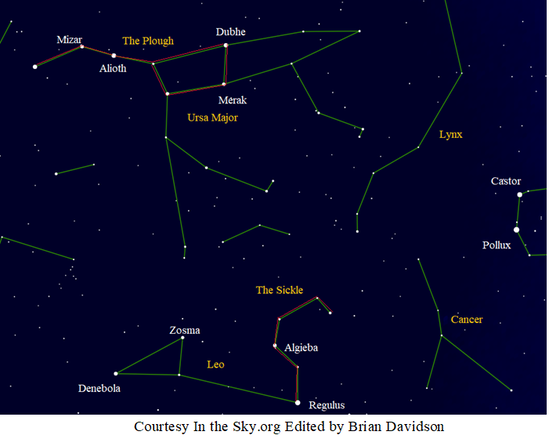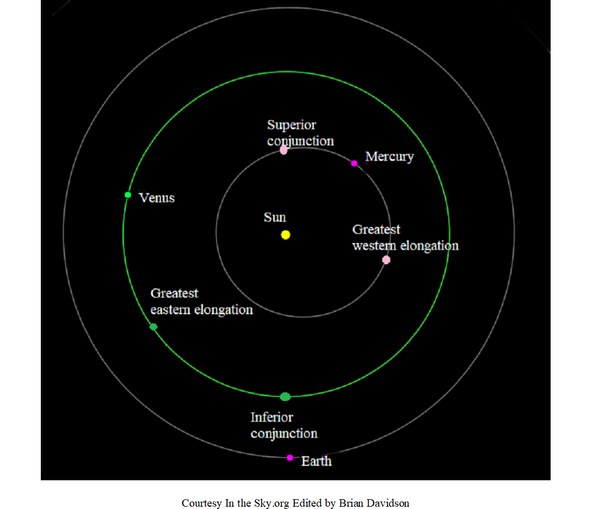|
We have had some clear evening skies recently giving us a good opportunity to see the winter sky in all its glory. As I suspected comet C/2022 E3 ZTF didn’t turn out to be as good a naked eye observation as suggested by some but I did see it with the aid of binoculars and my deckchair! There has also been the pleasure of seeing the planets Jupiter, Mars and Venus in the evening sky. Observing The following chart represents the night sky at 10.00pm GMT on the 8th of March and at 9.00pm GMT on the 23rd March. To use the chart, face south at the appropriate time with the bottom of the chart towards the horizon and you will see the stars in the chart. If you are observing earlier in the evening just turn eastwards by 15 degrees for every hour before the stated time but objects will be lower in the sky. The chart has some readily recognisable features this month viz. the constellation Ursa Major- The Great Bear with the even better known asterism, The Plough, outlined in red, and the stars Castor and Pollux in the constellation Gemini- The Twins which we highlighted last month together with the faint zodiacal constellation Cancer- The Crab. So no problems with navigation this month. The constellation Lynx- The Lynx is also shown but although quite large it consists of only a chain of faint stars so not much to see. I still like observing the plough throughout the year as it changes its orientation. Remember the pointer stars Merak and Dubhe lead you to Polaris the Pole star while a line from Alioth through Polaris leads you to Cassiopeia which is now closer to your northern horizon. Lastly, Mizar is a double star which some people with good eyesight can resolve into its components. A line from the Plough’s pointer stars in the opposite direction leads you down to our point of interest this month, the constellation Leo- The Lion. Like Ursa Major it has an easily recognisable asterism, The Sickle, outlined in red. The Sickle also looks like a backwards question mark. Both the constellation and the asterism bear a good resemblance to the objects they are meant to represent. The brightest star in Leo is Regulus located at the bottom of the Sickle or the dot at the bottom of the question mark. Regulus is a large blue-white star of magnitude 1.4 at a distance of eighty light years from Earth. Like so many stars it is part of a multiple system but to the naked eye presents as a single star. The three other named stars in Leo are not so well known but with magnitudes around 2.0 they make Leo stand out in the evening sky. You will be able to enjoy it more in the coming months as it rises higher in the sky. The Inferior Planets We have enjoyed watching Saturn, Jupiter and Mars over the past months and although Mars is still with us Saturn is entering conjunction (on the opposite side of the Sun from the Earth) and no longer visible and Jupiter is heading that way. However we have Venus to look forward to and, along with Mercury, it behaves differently because they are inferior planets. This is not a disparaging term it simply means their orbits are entirely within the orbit of the Earth. The chart below is a plan view of the solar system looking down on the orbits of Mercury, Venus and Earth with the Sun in the centre and should be helpful in explaining some terms in common use. Mercury (pink) and Venus (green) are never at opposition but instead are at ‘inferior conjunction’ when they are aligned with and lying between the Earth and the Sun. Venus is shown in this position on the chart. Likewise when they are aligned but on the opposite side of the Sun to the Earth they are said to be in ‘superior conjunction’. Mercury is shown in this position. It is clear from the chart that Mercury and Venus cannot be seen in the middle of the night because that view is away from the Sun and they are located in the opposite direction. Instead we can only observe these planets close to sunrise or sunset.
After inferior conjunction as they move round their orbits these planets gain angular separation from the Sun until they reach a maximum known as greatest western elongation which applies at sunrise and is exhibited by Mercury on the chart. The angle formed by the Sun, Mercury and Earth is 90 degrees so from Earth half of Mercury is illuminated and half is in shadow and this is also referred to as ‘dichotomy’. After superior conjunction they reach a maximum angular separation from the Sun at greatest eastern elongation (also known as dichotomy) and this applies at sunset. Venus is shown in this position. Clearly when planets are at greatest elongation it is a suitable time to observe them. The inferior planets exhibit phases similar to the Moon but with important differences. They pass through crescent and gibbous stages but at superior conjunction which corresponds to a full Moon, with the face facing Earth fully illuminated, they are at their furthest from Earth and so not at their brightest. Instead, in crescent phase close to inferior conjunction and corresponding to a new Moon they are at their closest to Earth and at their brightest. I hope this explanation of these terms will help when we discuss Venus in the coming months. Something to look out for Mercury is going through superior conjunction so won’t be visible this month. Remember Venus is shining at a magnitude of about -4.0 throughout the month so will be great to see. It has a close approach with Jupiter after sunset in the west on Thursday 2nd March. This year the spring equinox in the northern hemisphere is on Monday 20th March. On Wednesday 22nd March a slender crescent Moon lies south-west of Jupiter above the western horizon about 7.00pm. There is a close approach of the Moon and Venus low in the west after sunset on Friday 24th March. Finally there is a close approach of the Moon and Mars located in the constellation Gemini on the evening of Tuesday 28th March. Looking ahead, Venus will be at its highest altitude towards the end of April and reaches greatest elongation west on the 4th June. Clear skies.
1 Comment
|
AuthorWMA members Archives
July 2024
Categories |
Proudly powered by Weebly



 RSS Feed
RSS Feed